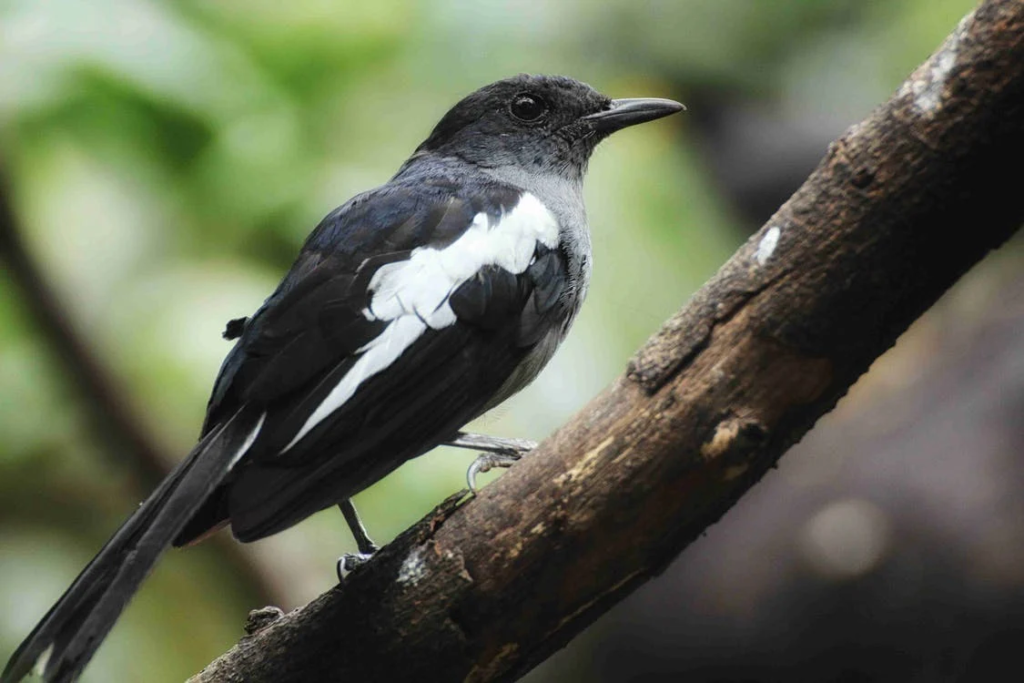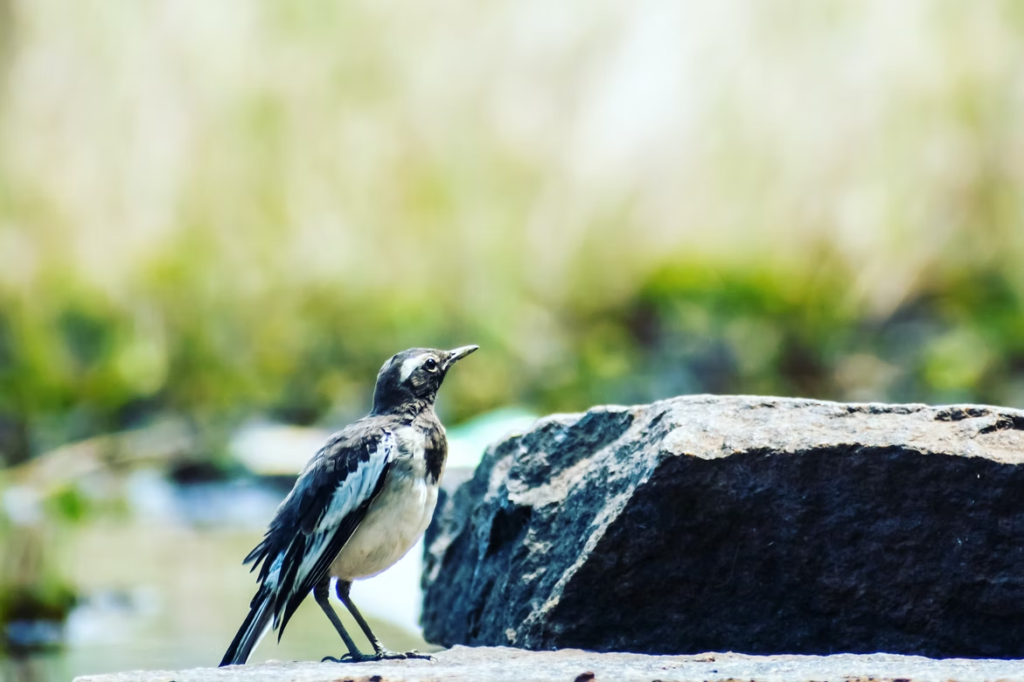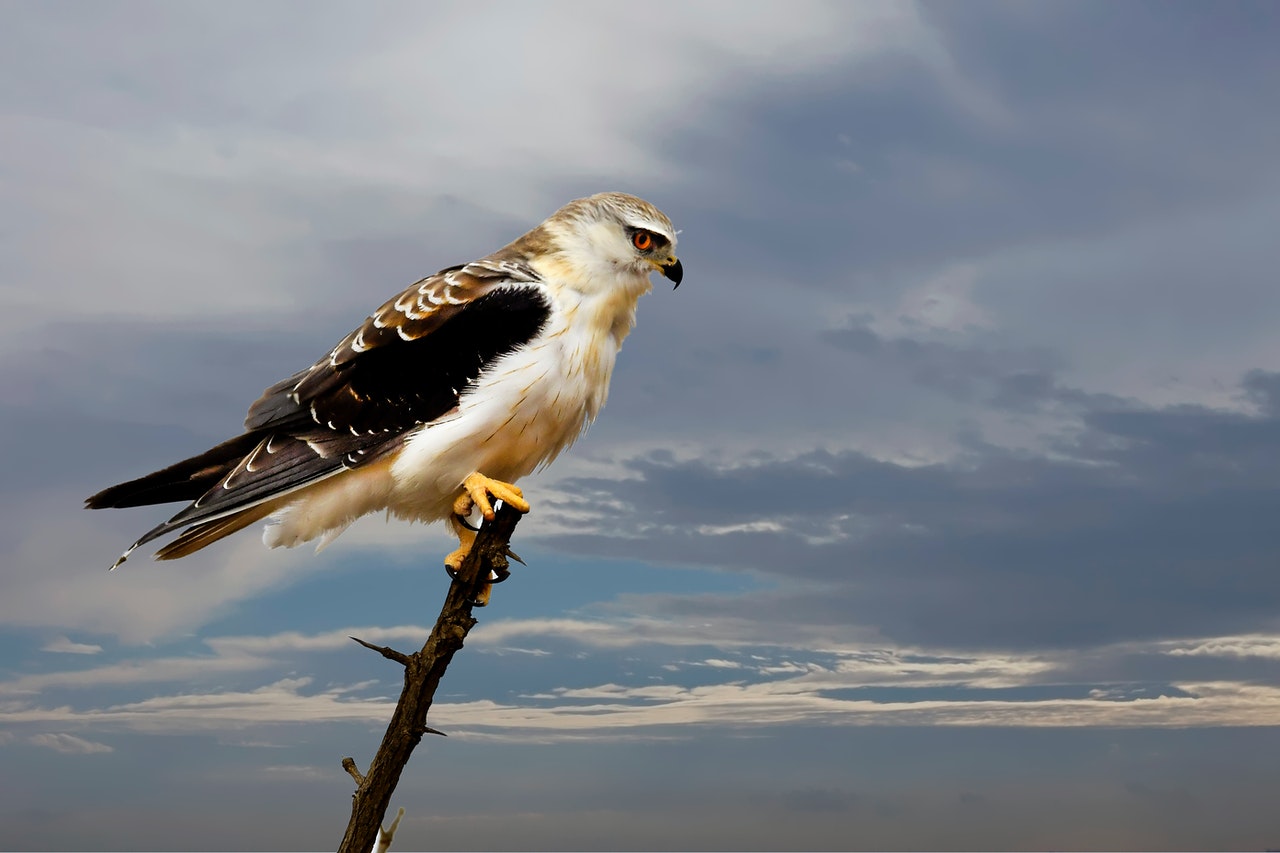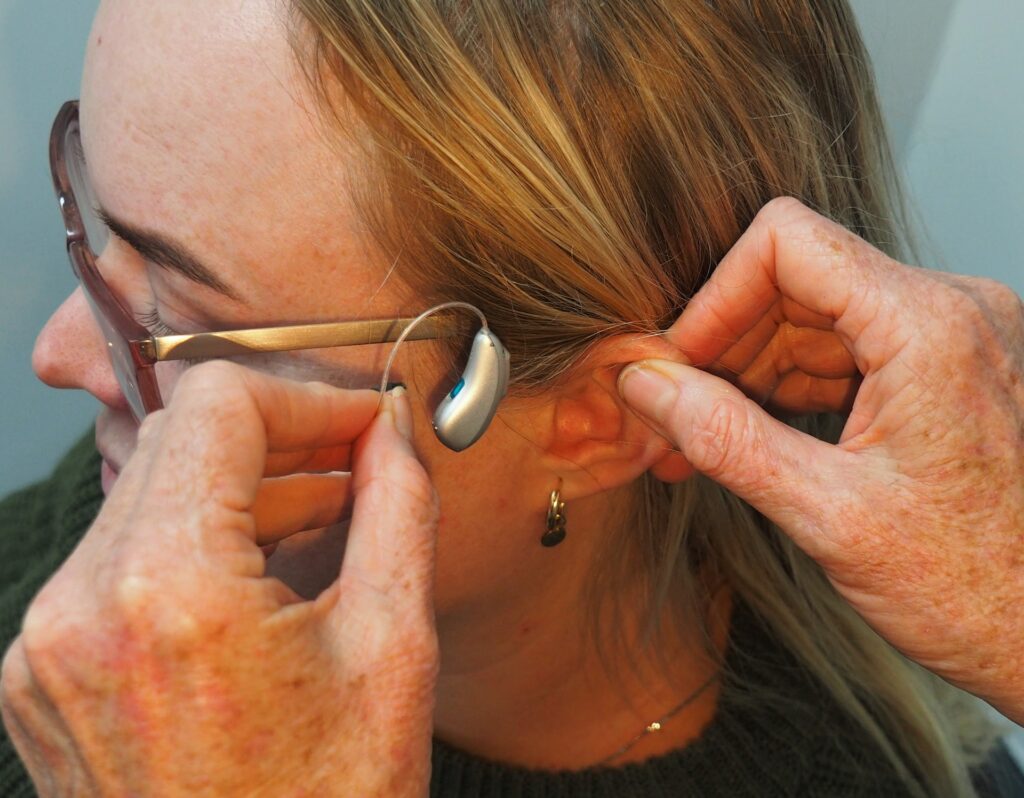These birds with white stripes on wings are some the most stunning in the world. The color white in Western culture symbolizes peace, purity, cleanliness, and perfection.
That`s why it’s amazing if you happen to see one in nature, and some of these birds fly at night.
So what kind of beautiful birds have white stripes on their wings?
We have a very long list when we talk about birds with white stripes on their wings. Northern mockingbird, Lesser Nighthawk, killdeer, Eurasian magpie, tricolored blackbird, lark bunting, and swamp boubou are just a few of them.
Let’s jump to the list and see over 20 species of birds with white stripes on wings below.
List of Birds With White Stripes On Wings
Northern Mockingbird

Scientific name: Mimus polyglottos
Wingspan: 12-15 in
Lifespan: up to 8 years
Native to: USA, Canada, and Mexico
Wing Stripes: Northern mockingbird is a medium-sized songbird with gray plumage, a white underbelly, and a long tail. They have white patches on their black wings that are easy to spot when they fly.
Their wing-bars have two benefits: to attract other birds during the mating season and to distract their enemies when they defend their territory from hawks or snakes.
You can find these birds on tree branches or tall shrubs of forest edges, parks, and backyards. It is the state bird of Arkansas, Florida, Tennessee, Mississippi, and Texas.
The mockingbird can imitate up to 35 different species’ songs. In its lifetime, the bird can learn over 200 different bird songs. This bird is the only one out of 16 mockingbird species that is originally from the United States.
Northern mockingbird’s scientific name literally means “many-tongued mimic”.
These birds are exceptional at breeding: one female can lay up to 27 eggs in one breeding season! They are also very territorial birds.
The northern mockingbird is an omnivore, and the diets include seeds, berries, fruit, and also small insects like moths, butterflies, beetles, earthworms, and bees.
Lesser Nighthawk
Scientific name: Chordeiles acutipennis
Wingspan: 21.5 in
Lifespan: 4-5 years
Native to: North America, South America, and Central America
Wing Stripes: Broad white wing stripes that are close to the wingtips
Lesser nighthawks have rounded wings and quite long, notched tails. They are frequently visible flying low over grasslands and deserts at dusk.
The small nighthawks have earthy-colored feathers that make them really good at camouflage. We can only spot their distinctive wingtips when they fly. The males have white stripes on the wings, while the females have cream-colored stripes.
The lesser nighthawk’s appearance is very similar to a common nighthawk. The visible difference is the position of the white patches on their wings. The white patch of a lesser nighthawk is close to the wingtip, while a common nighthawk’s white patch is close to the wingbase.
Lesser Nighthawks are famous for their unpredictable flying technique. They sometimes do bat-like flying and graceful loops, and they often change direction during a flight.
You can find many of these birds throughout Northern and Central California, southwestern Utah, Nevada, New Mexico, Texas, and Arizona.
These birds don’t make nests, and the females will lay eggs on the ground. They will use their bodies as camouflage to hide the eggs. Lesser Nighthawks are insectivores; they eat flying insects such as moths, beetles, ants, grasshoppers, and termites.
To adapt to the heat of the desert in their habitats, these birds may enter a hibernation-like state called torpor.
Eurasian Magpie

Scientific name: Pica pica
Wingspan: 20-24 in
Lifespan: 2-3 years in wild
Native to: Asia, Europe, and northwest Africa
Wing Stripes: White stripes on blue wings
The Eurasian magpie is a black bird with white stripe on wing. It’s also known as the common magpie, and the bird is a resident breeding bird that can be found throughout Asia, Europe, and Northwest Africa.
The bird has a black head, chest, and neck, as well as a green and violet sheen. There are some white streaks on its belly and noticeable white stripes on the longest wing feathers. Its shoulder feathers are white.
The Eurasian magpie is one of the smartest birds – it can use small tools, play games, work in teams, grieve, and even imitate human speech. It also passed the mirror test: it can recognize its own reflection in the mirror. Other animals that passed the mirror test are the great apes, elephants, and dolphins.
The bird is an omnivore, and they feed on other small birds and eggs, insects, small mammals, carrion, grains, and acorns.
Killdeer

Scientific name: Charadrius vociferus
Wingspan: 18-25 in
Lifespan: up to 11 years
Native to: North America
Wing Stripes: Bold white stripes on wings at the base of the flying feathers
The Kildeer is a large-sized plover that has a slender body, large eyes around the head, and a short break. They are mostly found in the Americas.
The Kildeer is a shorebird, but you don’t have to go to the beach to see this bird. It often can be found on golf courses, lawns, parking lots, and athletic fields in the United States and Canada. These birds are common sights in the west of the Cascade in Washington at any time of the year.
The bird has a brown back, a white underbelly, and white stripes at the base of its slender wings. The white stripes on the wings can be used to distract predators from its nest, as they make the wings look broken, and the bird would pretend to have a broken wing.
These birds are omnivores, and their food includes a lot of insects like grasshoppers, beetles, caterpillars, spiders, fly larvae, earthwards, crayfish, centipedes, and snails. They also eat some seeds.
The bird gets its name from the loud calls it makes that sound like it is saying: kill – deer, kill – deer.
Swamp Boubou
Scientific name: Laniarius bicolor
Wingspan: n/a
Lifespan: n/a
Native to: Southern and Western Central Africa
Wing Stripes: Clear white stripe that is visible when wings are folded
The bird is also known as the Gabon boubou and is originally from the savannah thickets, mangroves, coastal scrublands, and ravine forests of Botswana, Angola, Republic of the Congo, DRC, Cameroon, Namibia, Gabon, Zambia, and Zimbabwe.
The swamp boubou has a black upper body, white underparts, and a long clear white stripe on the wings. The bird looks similar to tropical boubou, but they have different bills, sizes, underparts, and singing.
This bird has a soulmate for life. The couple will sing in a duet that is started with a soft growling sound.
These birds are omnivores that eat worms, insects, and sometimes small fruits.
Lark Bunting

Scientific name: Calamospiza melanocorys
Wingspan: 10-11 in
Lifespan: n/a
Native to: North America
Wing Stripes: Bold wing patches
The lark bunting is a medium-sized American sparrow that is mostly found in the grasslands of the western and the centra; of North America. It is a state bird of Colorado, and it wins the most beautiful bird award in our list of birds with white stripes on its wings.
The breeding male has a black body with white wing bars. The wings become grayish brown with small white and black streaks in the winter. It has a pale blue-gray beak.
The lark bunting was chosen as a state bird of Colorado for its acrobatic mating dance and melodic song, and it is also a native bird of Colorado. The bird hops along the ground when grooming, and they will walk or even run when catching prey.
The bird is an omnivore that feeds on insects, seeds, and some fruits.
Evening Grosbeak

Scientific name: Coccothraustes vespertinus
Wingspan: 12-14 in
Lifespan: 15-16 in
Native to: North America
Wing Stripes: Noticeable white stripes on tertials of the wings and inner coverts
The evening grosbeak is a large and heavy-built finch with a thick neck and beak, a full chest, and a short tail. The male has a mustard-yellow thick body with noticeable gold stripes on the eyebrows. The bird also has large white patches on its black wings on the tertials and inner coverts.
These birds are mostly found in the southern parts of Canada at any time of the year. They can be found in some parts of the U.S. during the winter.
In the winter, evening grosbeak can be seen eating raw salt and fine gravel from the roadways. They also eat sunflower seeds. This bird can eat up to 100 sunflower seeds in 5 minutes.
Black-capped Chickadee

Scientific name: Poecile atricapillus
Wingspan: 6-8 in
Lifespan: 2-3 years
Native to: North America
Wing Stripes: White stripes in hockey-stick shapes on tertial edges and secondary coverts
Black-capped Chickadee is a small non-migratory songbird, and it is a state bird of Maine and Massachusetts in the United States, as well as the provincial bird of New Brunswick in Canada.
The bird has a large head, a short neck, a black cap and bib, and gray wings with white patches on the edges.
The black-caped chickadee got its name from the black cap on its head and its special calls that sound like “chickadee-dee-dee”.
The white-wing-striped chickadee is one of the most useful birds in the forest or orchard as it eats plenty of pests, including larva, insect eggs, lice, weevils, and sawflies. The bird also eats snails, spiders, and slugs.
White-winged Dove

Scientific name: Zenaida asiatica
Wingspan: 21 in
Lifespan: 10-15 years
Native to: Central and North America
Wing Stripes: Long white stripe on the edge of wings when folded
White-winged dove can be found in streamside woodlands, thorny forests, and deserts. This semi-tropical bird’s habitat extends from the Southwestern United States through Mexico and Central America to parts of western South America and several Caribbean islands. The bird was also found in Central Florida and Central Texas, where it was introduced.
The bird has grayish-brown plumage with a noticeable white patch on the wings. When the bird perches, the white streak looks like a line on the edge of the wing.
During migrating, white-winged doves can fly for 25 miles or more. They also can fly in a long-range in order to find water. These birds fly in flocks of 4,000 birds or more.
These birds are herbivores, and they eat seeds, including corn, sunflower seeds, milo, safflower, and also some berries from shrubs.
Tricolored Blackbird

Scientific name: Agelaius tricolor
Wingspan: 10-13 in
Lifespan: 13 years
Native to: Pacific coast of North America
Wing Stripes: White stripes on the wing’s median coverts
The tricolored blackbird is a social medium passerine bird that can be found in the grasslands and wetlands of the Pacific states.
The male tricolor blackbird has an entire back body with brilliant red shoulders and white stripes on the wings.
The female has dark gray-brown coloration with a streaked belly and back and with a cream-colored line around the eyes.
A large colony of tricolored blackbirds often includes tens of thousands of birds. These birds like to form large colonies from North America land birds. They are omnivores, and their food includes beetles, grasshoppers, seeds, weevils, snails, and caterpillars.
These birds are found along the Pacific coast of North America, from Northern California in the United States to Upper Baja California in Mexico, with occasional strays to Oregon.
Black-and-white Warbler

Scientific name: Mniotilta varia
Wingspan: 7-9 in
Lifespan: up to 11 years
Native to: North America
Wing Stripes: Two wide wing stripes
This medium-sized warbler is a small songbird with a quite long, slightly downcurved bill. The bird breeds in eastern and northern North America.
The black and white warbler has a distinctive coloration with bold black and white streaks all over the body. It has black wings with two wide white streaks.
Like any other warblers, these birds are very aggressive and territorial during the breeding season. They will attack and fight other species that invade their territories.
The black and white warbler is a good choice for birding if you are a beginner birder, as the bird is easy to see and recognize.
As an insectivore, this bird mostly eats insects like caterpillars, ants, beetles, bugs, flies, and also some spiders.
Daurian Redstart

Scientific name: Phoenicurus auroreus
Wingspan: n/a
Lifespan: 4 years
Native to: East Asia
Wing Stripes: Broad white stripe on wings
The Daurian redstart is a small beautiful bird, and it is mostly found in East Asia. This energetic bird is also known as jōbitaki in Japan.
The bird has an attractive coloration with a red-orange rump and tail, an orange underbelly, and a black beak. The Daurian redstart also has a remarkable white big patch on the wings. The female Daurian redstart has a more brown shade.
These birds can be found in open forests, agricultural margins, and forest edges. They are also sometimes seen in urban gardens and parks. Daurian redstart is an omnivore, and its food includes berries, insects, and seeds.
Daurian redstarts are monogamous, and the males will set up and defend their territories where they try to attract females.
Anhinga

Scientific name: Anhinga anhinga
Wingspan: 43 in
Lifespan: up to 12 years
Native to: USA
Wing Stripes: White streaks on the wings
The anhinga is a large and slender waterbird that can be found in lakes, marshes, wooded swamps, and ponds. The bird is also known as darter, snakebird, or water turkey. The name anhinga is originally from a Brazilian Tupi word that means snake bird or devil bird.
The male anhinga has a black coloration with white stripes on the wings. The female has the same coloration but with a brownish neck and head.
Anhinga’s wings are not waterproof like other waterbirds. When it swims, only its neck appears above the water, and that sometimes makes it look like a snake.
These birds are carnivores, and their diets include fish, crayfish, shrimp, and insects. They even sometimes eat small alligators and snakes.
White-browed Wagtail

Scientific name: Motacilla maderaspatensis
Wingspan: 12 in
Lifespan: 2 years
Native to: South Asia
Wing Stripes: Broad white stripe on the wing visible when perch or fly
The white-browed wagtail is a medium-sized bird with a noticeable broad white line around the eyes. The bird is also known as the large pied wagtail, and it has a black back, head, upper tail, white underbelly, and broad white stripes on its wings.
The white-browed has a long tail. This slender bird got its name from its constantly wagging tail.
The bird can be found in wetland habitats, especially in open freshwater. As a wagtail, this bird is insectivorous, and its food includes dragonflies, beetles, small snails, worms, spiders, crustaceans, and flies.
This bird got its Latin name after the Indian city of Madras, which is now known as Chennai. White-browed tails used to be kept in cages because of their beauty and singing ability.
American Goldfinch

Scientific name: Spinus tristis
Wingspan: 7.5-8.7 in
Lifespan: 3-6 years
Found In: North America
Wing Stripes: One broad white wing patch
This goldfinch is a small migratory bird that has a small head, a short and notched tail, and long wings with a broad white wing streak.
Both male and female American goldfinches have carotenoid-based red-orange beaks in the breeding season. The beak color also serves as an indicator of the bird’s overall health. The more orange the beak is, the higher the level of testosterone in that bird.
Identification of the level of testosterone in these birds is helpful in reducing the chance of birds fighting, injuries, and the loss of time and energy.
This bird sheds twice a year, during late winter and in late summer. The American goldfinch is the state bird of Washington, Iowa, and New Jersey.
Willet

Scientific name: Tringa semipalmata
Wingspan: 27.5 in
Lifespan: up to 10 years
Native to: North America
Wing Stripes: White stripes on wings
A willet has gray or brown coloration, and a striking white stripe on each wing is seen when it flies. Usually, you can find this large shorebird on bay shores, open beaches, mudflats, marshes, and rocky coastal zones.
Willet breeds from central Canada to northeastern California and Nevada, along the Atlantic and Gulf coasts of southern Nova Scotia.
Just like killdeers, willets used to pretend to have a broken wing to distract predators from their eggs or chicks. The willets have two subspecies: western willets and eastern willets.
This bird uses both its sensitive beak and eyesight to hunt, and it hunts food during the day and night. Willet is a carnivore, and it eats beetles, mole crabs, clams, and small fish.
White-headed Woodpecker

Scientific name: Picoides albolarvatus
Wingspan: n/a
Lifespan: up to 4 years
Native to: Western parts of North America
Wing Stripes: Small white stripe on the wing
The white-headed woodpecker is a non-migratory bird that can be found in pine forests of the mountains in the western states and also in British Columbia.
This bird has black plumage with a white head and small white stripes on the outer wings (primary feathers). The white-headed woodpecker is the only woodpecker from North America that has a black body and a white head.
These birds are so much quieter than other woodpeckers because they pry the tree bark rather than hammer it. The white-headed woodpecker also has a large beak, so it can eat large spiny cones easier.
The White-headed Woodpecker is monogamous. Both the pair take care of the eggs, and the male does all the nighttime work.
The bird is an omnivore, and its food includes pine seeds and insects.
White-winged Triller

Scientific name: Lalage tricolor
Wingspan: n/a
Lifespan: up to 3 years
Native to: Australia
Wing Stripes: Broad white stripes on the wing
White-tailed triller is a small songbird that has a short bill, a black back and crown, a white underbelly, and large white stripes on the wings.
You can find these birds in forests, open woodlands, and tree-lined waterways of Australia’s mainland and on the other islands to the north, including eastern Indonesia and New Guinea.
The bird is an omnivore, and it mostly eats insects, seeds, fruits, and sometimes nectar. White-tailed trillers can be very noisy during the breeding season.
Although this bird is monogamous, there were some reports that showed that some white-tailed trillers are polygyny.
American Avocet

Scientific name: Recurvirostra americana
Wingspan: 27-30 in
Lifespan: up to 9 years
Native to: North America
Wing Stripes: Large white stripes on wings
The American avocet is a large slender shorebird with a long upward beak that is curved, a long neck, and a round head. You can find this bird in saltwater and shallow freshwater in wetlands, impoundments, salt ponds, and evaporation ponds.
American Avocet has a white body during winter, with large white stripes on the wings and bluish-grey legs. The head and the neck become pinkish-tan during the breeding season.
The bird feeds on aquatic insects, and to get its food, it will put the bill underwater and move it side to side to stir the water.
The avocet’s chicks can swim and feed themselves after hatching. The American avocet is monogamous, and it is an omnivore with its food includes aquatic insects, fish, seeds, and crustaceans.
Yellow-headed Blackbird

Scientific name: Xanthocephalus xanthocephalus
Scientific name: Xanthocephalus xanthocephalus
Wingspan: 15 inches
Lifespan: 11 years
Native to: Western North America
Wing Stripes: White stripes on wings
The yellow-headed blackbird is famous for its golden head and its black wings with white stripes. This medium-sized blackbird has a black bill, legs, and feet.
The bird has a beautiful appearance, but not so much for the sound. Some people call it a bird with the worst sound in North America. It produces a sound that is like a rusty farm gate opening.
These birds are migratory and like to move in large flocks during winter. A single flock consists of hundreds of thousands of yellow-headed birds.
Magpie Lark

Scientific name: Grallina cyanoleuca
Wingspan: n/a
Lifespan: 10 years
Native to: Australia and Asia
Wing Stripes: White stripe from the shoulder to the wing
Another beautiful bird with a white stripe on its wings is the magpie lark. The bird has a quite long thin bill, and they are commonly found in dry forests, grasslands, and savannahs in Australia, Timor, and southern New Guinea.
This large songbird is an omnivore, and it feeds on spiders, insects, worms, reptiles, crustaceans, frogs, and sometimes seeds.
The magpie lark will sing in pairs where each bird in the duet will make one note for a second but a half-second apart. Sometimes the song is mistakenly identified as a single bird singing, not two birds.
Magpie larks have many other names, such as Peewit, Peewee, Mudlark, and Little Magpie. Their breeding season is from August to February, and the female can lay 3 to 5 eggs.
Closing Thoughts on Birds With White Stripes on Wings
This is the conclusion of the list of 21 birds with white stripes on wings.
Many species of birds like the magpie lark, willet, lesser nighthawk, lark bunting, white-winged dove, American goldfinch, killdeer, and anhinga are just a few that have white-striped on the wings.
The white stripes on the wings enhance their appearance so that some of these birds make amazing pets.
We hope that you will get the chance to witness any of these beautiful birds in the wild, and you will easily recognize them!





Leave a Reply
You must be logged in to post a comment.